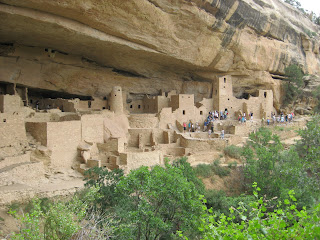It's also a great place to explore today as part of your western U.S. road trip. Located not far from the "four corners" area, Mesa Verde park makes an excellent addition to your western vacation planner. Mesa Verde is located between Durango and Cortez Colorado, both two good towns to also add to your summer vacation itinerary.
The Founding of Mesa Verde National Park
The Anasazi
Historians believe that about 1,400 years ago, the people who lived in what we call today the "four corners" (where the boundaries of Colorado, New Mexico, Utah and Arizona meet) moved up to the present site of Mesa Verde.
These people are referred to as the Anasazi. Since about 1936, archeologists used the term to describe these ancient Native Americans. There is some debate about the meaning of Anasazi. In Navajo, the term is spelled as 'anaasazi" which translates to "enemy ancestor" which is not what the use of the term implies today. Nevertheless, the term was coined in the 1800's and started to be used regularly around 1936. While some once believed that the people who lived in these magnificent cliff dwellings simply disappeared, in actuality they are considered the forefathers of the more modern day pueblo Indians who eventually moved to the south.
What we know mostly about the Anasazi was garnered from their petroglyphs and pictographs on rock walls. The petroglyphs are found in many places in the American southwest in addition to Mesa Verde National Park.
Both Bandelier National Monument and Petroglyph National Monument, both in New Mexico, are good examples. Originally thought to be a nomadic people, the Anasazi eventually built a close knit society comprised of cliff dwellings and free standing stone structures several stories high. They also became accomplished farmers. Far from being a primitive group of people, the Anasazi raised crops such as squash and went on to produce baskets, pottery and weaving items that evolved from cord to cotton. Over the centuries, the Anasazi developed the bow and arrow which was a better hunting weapon than a spear.
The structures the Anasazi built were quite impressive as the photos on this page illustrate. Multi-storied structures could contain hundreds of rooms. As you can see, the structures were built on rock ledges.
Why Did The Anasazi Leave?
The biggest question that's asked regarding the Anasazi is...why did these people abandon their highly crafted cliff dwellings and move to the south into today's New Mexico and Arizona?
As you can imagine, there have been many different answers proffered. Archeologists have discussed issues such as drought and sanitation problems.
Possibly their move south was a result of warfare. One probable explanation may have been that the Anasazi simply outgrew their dwellings and needed to move to more open spaces.
There's also some evidence that the migration away from the Mesa Verde area may have occurred over hundreds of years and took place family by family as opposed to one mass movement. That being said, the prevailing story among many historians and archeologists seems to be that a severe drought caused the exodus. This may be just one of those curiosities that will never be answered for certain.
The modern pueblo people can claim to be direct descendents of the Anasazi, although as mentioned above, there is some dispute among tribes as to the meaning of the term. The modern puebloans built a culture along the same lines as the ancient ones. Stone and adobe structures are the mainstay. A history of active agriculture also binds the two groups together. The Spaniards discovered these Native Americans with their multi-storied family houses and gave them the name "pueblo", which in Spanish refers to a village. When you travel and vacation in New Mexico, you will see the adobe architecture just about everywhere.
Today's modern adobe styled structures are built with thick walls made of wood frame, concrete block or a combination of both. The original true adobe structures were built primarily of mud and straw. One benefit of essentially using the earth itself as a building material was that it kept the inside temperature relatively constant or within a general range. The downside to this type of construction was that, over time, it would deteriorate to the point of collapsing. As an example, New Mexico was and is home to many original adobe structures such as churches or missions which did indeed fall down.
The centuries old civilization of the Anasazi and their descendents in the American southwest is a fascinating subject to read about and a great area of the United States to visit.
The religion, culture, pueblo living, and the arts and crafts that have been passed down over the centuries offers the visitor or tourist a chance to learn much more about the people who inhabited the southwest long before the Spanish Conquistadors landed on the continent.
As you can see from the Mesa Verde photos above, the scenery is very unique. I think you'll find your trip to Mesa Verde National Park in Colorado a fascinating visit and probably quite unlike any you've taken in the past.
(Photos from author's private collection. Images of kachinas are public domain. Article copyright Western Trips)
View Larger Map





